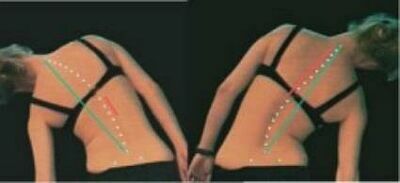
Computer-aided examination of schoolchildren's postural faults
H.P. Holzer
Institute of Sports Sciences, Graz, Austria
The alarmingly poor posture of our schoolchildren calls for action! Our studies showed that more than 80% of Styrian schoolchildren aged between six and eight suffer from severe postural problems.
The method employed in this examination was the so-called 'video screening of the spine' - a technique developed in Graz, in which the children's spinal processes are marked with small reflective stickers without putting a strain on the children themselves. The children are then videotaped from behind and from the side while walking and taking various positions, e.g. standing upright, or bending forward or to the side. With the help of the reflective stickers, the structure of the children's spinal columns can be easily analysed (Figure 1). Tests of coordination skills and muscle function, as well as an orthopaedic check-up, complete the examination.

Figure 1. Videotaping a subject whose spinal processes have been marked with reflective stickers.
To carry out many comprehensive examinations in a row, a software program for analysing, storing and documenting the postural faults had to be developed. Today, the 'Spine Analysis System' makes it possible to transmit selected frames of standardised positions via digital video directly to the computer (Figure 2). The doctors or therapists who analyse the data collected are given a context menu for each frame, from which they select the desired parameters. For essential parameters (such as scoliosis, hollow back, round shoulders, etc.), a frame database of deformities of different degrees in various positions is available. By videotaping standardised positions, the structure of the spinal processes can be palpated automatically, using virtual tools like protractors or plumb lines.

Figure 2. Tailoring an individual exercise programme with the Spine Analysis System.
After each evaluation is complete, a suitable exercise programme is selected. According to the postural faults of each child, the program 'WIRBEL-MED' suggests a set of focal and alternative exercises from a range of more than one hundred. The doctor or therapist composes the final programme and prints it out for the children, together with all the relevant instructions. This software has proven to be of great help for doctors and therapists in the standardised analysis of postural faults.
Paper presented at Measuring Behavior 2002 , 4th International Conference on Methods and Techniques in Behavioral Research, 27-30 August 2002, Amsterdam, The Netherlands